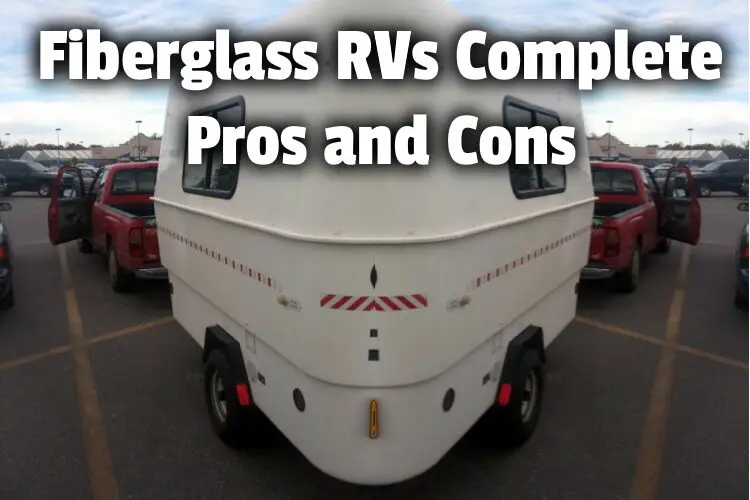
Fiberglass is a relatively new material that has been taking the RV world by storm in recent years. So why is fiberglass so popular, and what are the fiberglass rv pros and cons?
The pros of fiberglass panel RVs are:
- They provide good insulation
- Reduced noise when driving on the roads
- Lightweight and more fuel-efficient
- Better resale value
But the cons include:
- Fiberglass being expensive
- Not being as easy to customize as aluminum RVs
- Laminated fiberglass prone to warping
- Scratches and dents are much harder to fix
- Can’t drill through molded fiberglass
Let’s look at why fiberglass is used in RVs over traditional materials and whether you should get a fiberglass RV. I’ll also go over the drawbacks of fiberglass RVs.
And don’t worry. I’ll get into both molded fiberglass as well as fiberglass panel RVs.
Get a little fiberglass RV, Hannah! I used to live in a 13′ that was only 1800lbs and I pulled it with my Jeep! #CultureTrav pic.twitter.com/wA9oPs5JJn
— MattsRoadTrip (@MattsRoadTrip) January 10, 2019
How do molded fiberglass RVs differ from fiberglass siding RVs?
A molded fiberglass RV is literally just 2 pieces of fiberglass that were made in a mold. Then the 2 pieces are joined together at the seam.
The plus side is that seam is the only possible point of entry for water, bugs, etc.
Think of it kind of like a molded plastic milk jog. It’s literally all 1 piece (well 2 pieces as we discussed). So there aren’t corners or multiple places where 1 piece is joined to another.
Fiberglass panel RVs, by comparison, are built on a frame (either wood or aluminum). Then fiberglass panels simply get attached to that frame.
In that regard, they aren’t a lot different than aluminum-sided RVs. Unless specified, most of the time below, we’ll be talking about molded fiberglass RVs.
What are the pros of fiberglass RVs?
Fiberglass RVs have better insulation than other RVs, such as aluminum RVs.
This is because fiberglass is not a metal. Metal molecules have metallic bonding, as this means they have a free electron that circles around the molecules in the metal. This means metals are good at absorbing heat and transmitting electricity. Fiberglass RVs have non-metallic bonding; therefore, they don’t conduct electricity and heat.
This is important if you are traveling in the winter, as you need an RV that will keep heat inside. If you travel in the desert, RVs made of fiberglass are better than metal ones, as the metal sheets will actually draw heat in from the surroundings.
Another way fiberglass RVs keep cool is by usually having white paint on them. The white paint helps to reflect light and keep the RV cooler than if it was painted a dark color like grey.
Fiberglass RVs also reduce the noise you hear when you are driving. There is nothing more annoying than hearing just the road when you are traveling, and it can be pretty tiring, actually.
Sound travels in waves, and sound travels better through denser objects. Metal RVs are harder and denser than fiberglass RVs, so they are noisier. If you want to drive in quiet and comfort, fiberglass RVs are the way to go.
Fiberglass RVs also look better than other RVs, as the fiberglass is often painted white or with a nice glossy finish. The smoothness of fiberglass RVs is not just aesthetic, however. The smoothness also reduces the chance of the dust and debris getting stuck on the surface of the RV.
Dust and debris not only look bad, but they can also scratch your RV.
Fiberglass RVs look great, and they are really practical and durable, and as a result, fiberglass RVs depreciate much slower than RVs made of other materials such as metal. So, if you are getting your first RV and are likely to get a new one in 5- or 10-years’ time, you might as well get a fiberglass one where you will lose less money.
Fiberglass RVs are less likely to dent. The metallically bonded molecules of metal RVs mean the metal is malleable, as all the particles are in one uniform line. With fiberglass, the molecules are bonded in a lattice, and this makes them really, really durable against dents.
Fiberglass RV Rally October 2017 https://t.co/9mT9W4AVqK pic.twitter.com/17yGDYeiJz
— TeachNorthTexas (@TeachNorthTexas) October 24, 2017
What are the cons of fiberglass RVs?
Fiberglass RVs can be expensive, as the manufacturing process for fiberglass is more complex and has more steps than the process used to mine and refine other RV materials like metal. Also, molding fiberglass into the shape required for RVs is very expensive and requires specialist equipment that is not as widely available as metal-pressing equipment.
Another drawback of molded fiberglass RVs is the weight of the RV.
Molded fiberglass can be heavier than other RV materials like aluminum, wood, and plastic. Now fiberglass siding doesn’t have this issue. So we’re just talking about molded fiberglass RVs.
This may be an issue, as in some countries, there are limits to how heavy your RV can be, and you need to take special training to drive anything over a certain weight.
Also, there are some RV parks around the USA and other countries where they have weight limits.
A heavy RV also burns through more fuel and is less agile, so if you are driving across the country or if you are going to have to drive up a tricky place with sudden drops, you would want a smaller, lighter RV.
I remember driving up independence pass in the mid-2000s with my family. There were no guard rails and 100-foot drops, and I was petrified! Thank God my RV was light enough for me to maneuver it up that hill!
The final drawback I can think of with fiberglass RVs is the fact that they are prone to damage from UV rays.
This is a big problem, especially if you are going to use your RV in the desert or on beaches. If you are going to use your fiberglass RV under the sun, you need to make sure you are prepared to inspect the paint job regularly and re-coat it when needed.
Some fiberglass RVs have additives added to them in the manufacturing process.
Additives are substances added to the fiberglass in order to enhance its properties. UV-protective additives are being used more and more in fiberglass vehicles such as motorhomes, boats, and go-karts, but these fiberglass vehicles are more expensive.
Cute trailer camper series. Trillium, Burro, Acorn, Scamp, and Boler travel trailers converge for the 11th annual fiberglass rv rally in Quartzite, AZ. #fiberglasstrailers #cute #vintage #Acorn #Scamp #Trillium #Burro #Boler #rv #rvlife #homeiswhereyoup… https://t.co/0kG6OQGKu8 pic.twitter.com/hqFN6EBNsT
— Ava Weintraub (@AvaWeintraub) February 17, 2018
What are fiberglass RVs like?
Fiberglass RVs tend to be a little smaller than other RVs simply due to the weight of the fiberglass. Also, large RVs made of fiberglass would be incredibly expensive. Most fiberglass RVs are under 20 feet long; however, some go up to 25 feet.
If you are going to travel for long periods and need a larger motorhome up to 40 feet, then fiberglass might not be the best RV material for you unless you are really wealthy.
Fiberglass RVs are also prone to delamination if water gets between the panels and the wooden parts of your RV. You will have to repair any water damage quickly. Otherwise, the dampness will spread, and the wood all over the side of your RV will rot.
Of course, RV roofs really need to be resealed every year.
Check out this recent article on my site where I talk about the best roof sealants for your RV. I’ll go over the types of sealants, why you need to have a good sealant, and which sealant you need for your specific RV. But I also show you just how easy it is to do this yourself.
Just click that link to read it on my site.
Many fiberglass RVs are also hard to customize, as they have fiberglass inside the RV too. Many of the furniture and other things inside fiberglass RVs can’t be replaced.
Foretravel was one of the first to implement fiberglass instead of aluminum, real hardwood, and a full air bag suspension to their motorhomes.#funfactfriday #foretravel #motorhome #homeiswhereyouparkit pic.twitter.com/rqkrOTsdD3
— Motorhomes of Texas (@motorhomesoftx) August 23, 2019
What type of RV lasts the longest?
Fiberglass RVs last the longest, as they are the most durable, have the best insulation and are most resistant to dents and scratches. But aluminum RVs last a long time too. Woodframed and plastic RVs are the least durable, and steel RVs are really heavy and not worth the price.
One thing you have to remember is that it does not matter what material your RV is made of.
If you don’t look after the RV, it won’t last. A metal RV that is constantly cleaned, inspected for damage, and repaired will last much longer than a fiberglass RV that is worn out and never maintained.
How To Polish RV Fiberglass The Right Way 👍 #DIYRV #RVDIY #rvlife https://t.co/jvUKHODTnx pic.twitter.com/fX7U4NhlpQ
— DoItYourselfRV.com (@DIYRV) December 7, 2021
Is it worth buying a Fiberglass RV?
If you travel frequently and plan to buy an RV, then fiberglass RVs are worth the cost. This is because fiberglass RVs retain their value, and they are very durable and comfortable.
If you use your RV infrequently and plan to keep it for as long as it lasts, then a metal RV will be sufficient for you. Avoid metals like steel, and don’t buy an RV made of plastic or wood, as it will get damaged too easily.
Let’s review the most popular types and average lifespan:
| Type of Building Material | Average Cost for a new travel trailer | Average lifespan |
| Molded Fiberglass | $65,000 | 15-20 years |
| Aluminum-Framed Fiberglass | $65,544 | 8-10 years |
| Hybrid Aluminum & Fiberglass | $45,901 | 10-15 years |
| Aluminum Framed | $34,605 | 10 years |
| Wood Framed | $25,691 | 15-20 years |
It’s also worth pointing out that generally speaking, Airstream trailers last longer than most other types and brands. Airstreams are aluminum framed with laminated aluminum panels over the framing.
Conclusion
Fiberglass RVs are some of the most durable RVs you can buy. They provide good insulation, look good, retain their value, and are comfortable. The downsides to fiberglass RVs are the cost and weight of the RV.
If you want to learn more about how to select the best motorhome for your needs, check out this recent article on my site.
Photo which requires attribution:
1997 Lite House Camping Trailer. by macguys is licensed under CC2.0 and was cropped, edited, and had a text overlay added.
